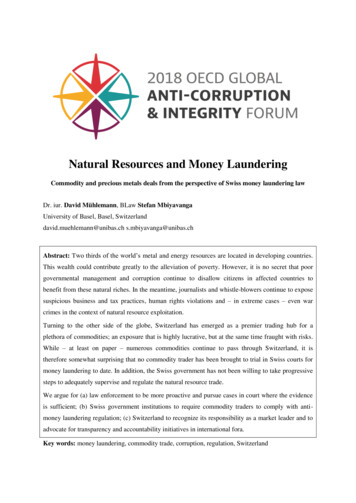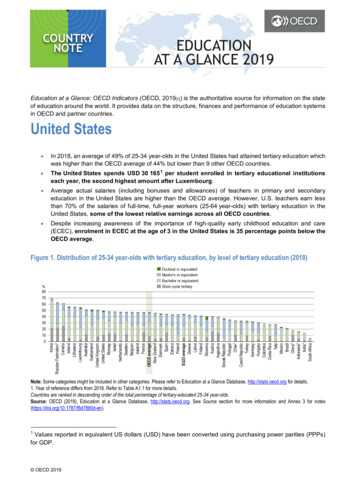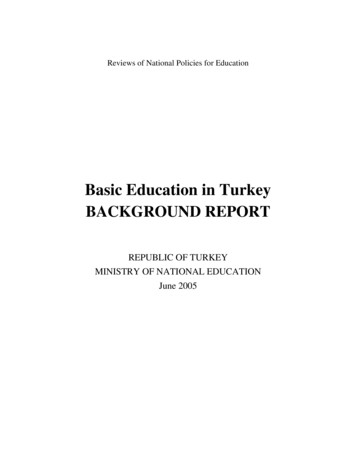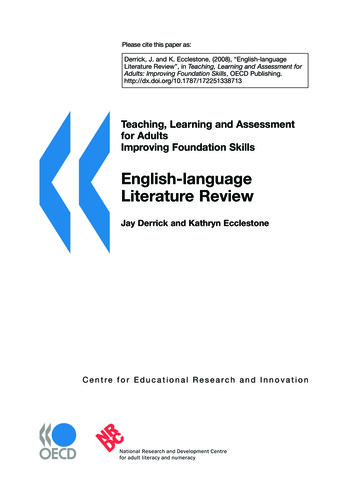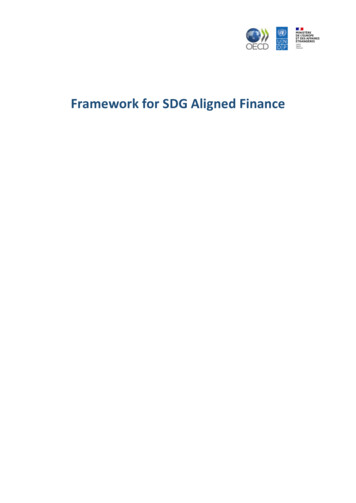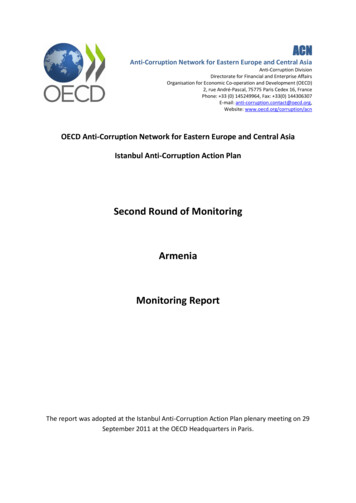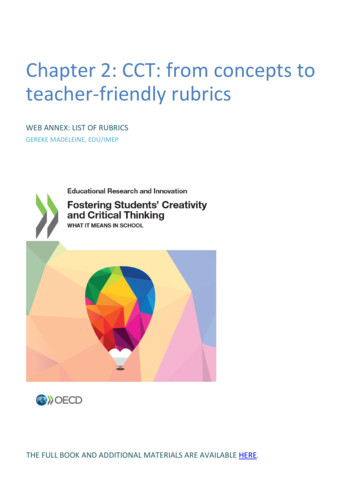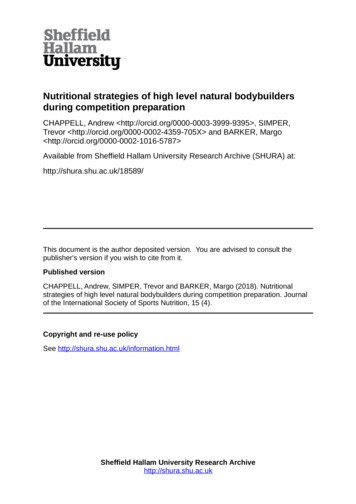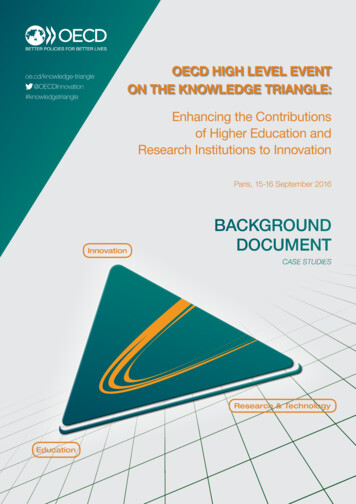
Transcription
riangleOECD HIGH LEVEL EVENTON THE KNOWLEDGE TRIANGLE:Enhancing the Contributionsof Higher Education andResearch Institutions to InnovationParis, 15-16 September 2016InnovationBACKGROUNDDOCUMENTCASE STUDIESResearch & TechnologyEducation
KNOWLEDGE TRIANGLE: CASE STUDY SUMMARIESThis document presents the draft summaries of the case studies of the knowledge triangle carriedout by countries participating in the OECD project.Introduction1.Higher education institutions (HEIs) and public research organisations (PROs) are central actorsin innovation systems. The Knowledge Triangle approach in policy calls for a better integration ofeducation, research and innovation at HEIs and PROs in order to increase their contributions to the localand national economy. But the diversity of institutional models means that their contributions to innovationvary greatly within and among countries.2.This document presents the draft summaries of a series of country case studies that have beenprepared by countries participating in the OECD-TIP project, using a common template, in order to explorethe national policy frameworks and institutional level practices for integrating research, education andinnovation activities of higher education institutions. The project is therefore particularly focused on thepolicies, or suites of policies, and institutional practices that can improve the collective contribution ofresearch, innovation and education to economic growth and integration of higher education and publicresearch institutions into regional and national innovation systems.Theoretical framework3.The knowledge triangle is a policy framework that stresses the need for an integrated approachtowards research, innovation and education policies, especially those directed towards higher educationinstitutions which fulfil several important roles in national innovation systems. As such the KT concept isgrounded in the national innovation systems (NIS) framework which emphases the systemic nature ofinnovation and the role of different actors (firms, public research in an innovation system and theirrelationship with others actor and the surrounding environment, notably markets). The role of universitieswithin national innovation systems depends on a range of factors such as the level of R&D performed inuniversities compared to public research organisations (PROs) or the structure and levels of business R&D.In OECD countries, the national innovation systems can be characterised as firm-centric or public –research centric (and with this last category, university-based or public research institution-based). As aresult, the place that HEIs occupy within national innovation systems can be argued to be inherently tied tolong-term, structural economic factors in a path-dependent process (Mowery and Sampat, 2005).4.The nature, type and quality of the interactions between research, innovation and education areimportant determinants of the overall performance of national innovation systems. Investments in one sideof the KT tend to positively affect not only the other two sides but also create external impulses, fromupgrading the labour market and fostering structural economic change to inspiring society, at large – oftenwith a strong, place-based context.5.Notwithstanding these differences in national innovation systems, the knowledge triangleapproach attributes a central role to higher education institutions (HEIs) in fostering the integration of2
innovation, research and educational activities. The KT framework postulates that each of the linkages inthe triangle can be strengthened by means of platforms and processes that build bridges between education,research and innovation (Sjoer et al., 2011).The KT acknowledges the potential complementarity andconflicts between research, innovation and education and promotes a holistic approach to harnessing allthree levers for economic growth and welfare. A novelty of the knowledge triangle concept is that it drawsattention to the contribution of education and entrepreneurship to research and innovation and vice-versa.Traditionally, higher education and research policies have been concerned with the contribution ofeducation for labour market success or the training of higher quality graduates for research activities. Withregard to the innovation function, most policies in the last decade have focused on increasing thecontribution of research to innovation through legislative reforms (e.g. Bayh-Dole Act) and theestablishment of hard and soft infrastructure in the form of technology transfer offices or other interfacesbetween public research and industry. However more recently the HEIs are facing pressure to measure andquantify the their contribution to innovation in the context of international ranking and evaluation exercises6.The central idea behind the KT framework is that creating new knowledge from research andhigh quality education are in themselves are not enough to gain prosperity and economic growth (Stam et.al, 2016). In contrast to the Triple Helix model of university-industry-government collaboration, the KTframework places a premium on the role entrepreneurship both as a channel to diffuse knowledgegenerated at HEIs but also as way to foster greater societal engagement from within the institution. It is inthis way it is more outward and directionally oriented than Triple Helix models where the emphasis is on astrict division of labour among the actors (university-industry-government) and the modes of co-operationbetween them. Furthermore, the KT framework recognises the need for institutions themselves to innovatewithin institutions in order to better articulate and carry out their different missions.Main cross-cutting messages from the case studies thus farNational policies, budgetary pressures, demographics and global competition are putting pressure onhigher education to differentiate themselves and strengthen their engagement with society and socioeconomic impacts7.In the large majority of OECD countries, the pressure on higher education institutions to engagewith society at national, local and global level is high. Furthermore, the rise of the global competition fortalent and for national research funding is also putting pressure on institutions to differentiate themselvesand develop their institutional profiles vis-a-vis not only national ministries but especially students, facultyand companies. In some countries like Sweden, this pressure is felt in all dimensions of the missions of theuniversities. Institutions are under increasing pressure to maintain and strengthen excellence in research,education and societal engagement. This leads them to find ways to combine their missions in a strong“knowledge triangle” (Benner, et. al. 2016). In other countries, such as Estonia and the Czech Republic anddue to funding arrangements (i.e. a large share of competitive research funding or reliance EU Structuralfunds) this pressure (for excellence) is felt mainly with regard to the research function of institutions.Low prevalence of the “knowledge triangle” concept outside policy circles despite increased attentiontowards third mission and KT activities8.The analysis from the case studies suggests that while governments and higher educationinstitutions recognise the importance of industry-science relations, the term “knowledge triangle” is notwidely used outside policy circles. Even in Germany, to which some observers attribute the first “triple3
helix” institutions in the form of the Kaiser Wilhelm Institutes of the 19th century (Fuller, 2009), theknowledge triangle is not explicitly mentioned by the institutions surveyed in the case study. However,there are many KT related developments taking place in Germany, mostly between research and innovation(i.e. traditional “third mission” of HEIs) and between research and education (strongly reinforced in thepast few years by instruments aiming at a higher quality of teaching and between innovation and education(e.g. via business participation in the accreditation process of new Bachelor and Masters studyprogrammes) (Daimer and Rothgang, 2016). In Sweden and Norway the knowledge triangle concept iswell anchored in governmental, institutional and political discourses and also used by institutions. In othercountries such as the Czech Republic, Japan or Korea the discourse regarding the third mission is morearound technology transfer and industry-science relations. In Estonia, engagement by universities withsociety is a relatively new phenomenon given the country’s socialist economic history.There is a diversity of HEIs, diversity of needs and a diversity of approaches to the knowledge triangle9.Another key message is that because of the diversity of HEIs (i.e. comprehensive universities,universities of applied sciences, technical universities or regionally oriented universities) in countries,regions and innovation eco-systems more broadly, it is likely there is no single model that countries shouldaspire to. Institutional characteristics vary between and across countries. The case studies in Norway forexample show that KT-practices differ significantly between scientific fields. Health sciences have a clearmission to contribute to high-quality healthcare services and KT-practices are integrated in the specialisthealth care services through the national system for interaction between the public hospitals and medicalfaculties, and are as such top-down driven.10.The perceived societal role and impacts of HEIs on innovation varies across countries due tohistorical, economic and cultural factors. Levels of government oversight vary significantly acrosscountries and, as a result, institutions have very different levels of accountability and freedom to decidetheir own practices. While research and doctorate training are common ways in which knowledge isgenerated and from HEIs, and as illustrated in several of the case study, a significant share of HEIs do notundertake significant research or teach doctorate degrees. These issues are likely to differ according toscale and geographic location. Smaller institutions or those in low-R&D areas face different challenges ininteracting with external research and innovation than large institutions in large cities (See paper onplace-based policies for HEIs: DSTI/STP/TIP (2016)1).11.In fact, governments in many OECD countries envisage different national and regional roles fordifferent types of institution. For example in Finland, universities are considered to have a strongernational and international role, while polytechnics are assumed to focus on their regional role (OECD2007a). In Greece and Estonia, universities of applied sciences have been assigned a regional role that isdifferent from the more international role of comprehensive universities. This does not mean that onlycertain types of HEI contribute to certain missions. However there is an element of specialisation anddifferentiation in higher education systems that will shape the type of “knowledge triangle”. This alsomeans that some HEIs will have different needs when implementing strategies for the KT. Some may needto focus more on strengthening education in order to link with innovation for example.12.Nevertheless countries- and HEIs- share many of the same challenges in integrating research,education and innovation policies and the case studies of HEI eco-systems suggest there are certain areasof policy and institutional set ups that will require attention.4
13.The first of these concerns the influence of the governance of STI and higher education policiesat national level. Governance of HEI activities is a complex and contextually based. Different structureshave emerged according to historical processes and policy changes. The second concerns the role ofdiverse funding sources and contractual arrangements may have on HEI incentives to change or toinfluence their behaviour. A third area concerns the link between place-based policies and HEI’sglobal-local engagement; and fourth element concerns the role that evaluation and impact assessmentcriteria play in supporting KT activities.Multi-level governance arrangements for the knowledge triangle14.HEIs have been the object of government-initiated reforms for the past decades. Four mainpolicy goals have characterised reforms. First, successive reforms have granted increased autonomy andaccountability of higher education institutions across OECD countries. Second, increasing demand foraccess and quality in higher education and third, increasing the quality and excellence of research. A fourthgoal and one that is often pursued either sequentially or independently of the other two, is the promotion ofindustry-science relations.15.In all of the countries surveyed in the case studies, governance mechanisms such as project-basedfunding, university performance contracts and research assessment exercises are common tools to increasethe accountability of HEIs on the one hand, and to enhance knowledge triangle activities. However,because of the autonomy granted to HEIs, the task of co-ordinating and integrating the multiple missions ofuniversities falls on the institutions themselves.16.One of the lessons from performance contracts in OECD countries is that they have helped HEIsimprove strategic planning and adapt to a changing funding landscape and position themselves in a globalmarket for research and education. But the challenge remains how to properly assess performance and tomake the performance of individuals accountable to the institutional performance.17.Diversity of funding, performance indicators and evaluation practices make implementing andmeasuring KT activities difficult. The funding sources of HEI are increasingly diverse in terms of theirsource (i.e. national, regional, international, business and charities) but also their nature (institutional blockgrants, competitive pro
KNOWLEDGE TRIANGLE: CASE STUDY SUMMARIES This document presents the draft summaries of the case studies of the knowledge triangle carried out by countries participating in the OECD project. Introduction 1. Higher education institutions (HEIs) and public research organisations (PROs) are central actors in innovation systems. The Knowledge Triangle approach in policy calls for a better integration of
